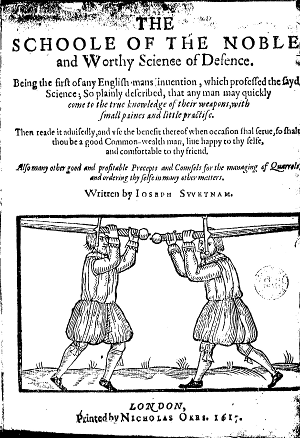A&S
Thoughts on Reading Swetnam
Well I’m kinda back. I’m only allowed to pick up my sword for 15 minutes at a time, but I have my strength coming back to most of my body and I’m on a lot fewer drugs, so my head is much clearer. This means that I can get back into some of my studying. After my work with Saviolo I very much wanted to move on to Joseph Swetnam. So it’s time for that now. With Saviolo I found that I didn’t like his writing style as much as I did Di Grassi (though I liked the content more), so it’s interesting to me to see Joseph Swetnam’s style which seems very different from the earlier masters. I’ll be writing this as I go through his Schoole of the Noble and Worthy Science of Defence which was published in 1617.
Similar to Di Grassi and Saviolo I’m reading Swetnam in the original. This is the big reason why I’m starting with the English masters and not the Italianate ones. I would like to get a grounding in the thought of the time rather than read it through the eyes of a translator.
First Di Grassi published his work in 1570 (translated into English in 1594) and Saviolo published in 1595. I still think that Saviolo’s work is derivative of Di Grassi’s, and subscribe to the thought that Di Grassi’s manual was taught in Saviolo’s school before his own manual came out. I did find a number of parallels between Saviolo’s work and dall’Agocchie’s work which came out a few years prior.
Joseph Swetnam published in 1617 – 22 years later. Saviolo should thus be a completely new generation of fencing. His work is more likely to be derivative of Fabris, Giganti, and Capoferro but from an English perspective.